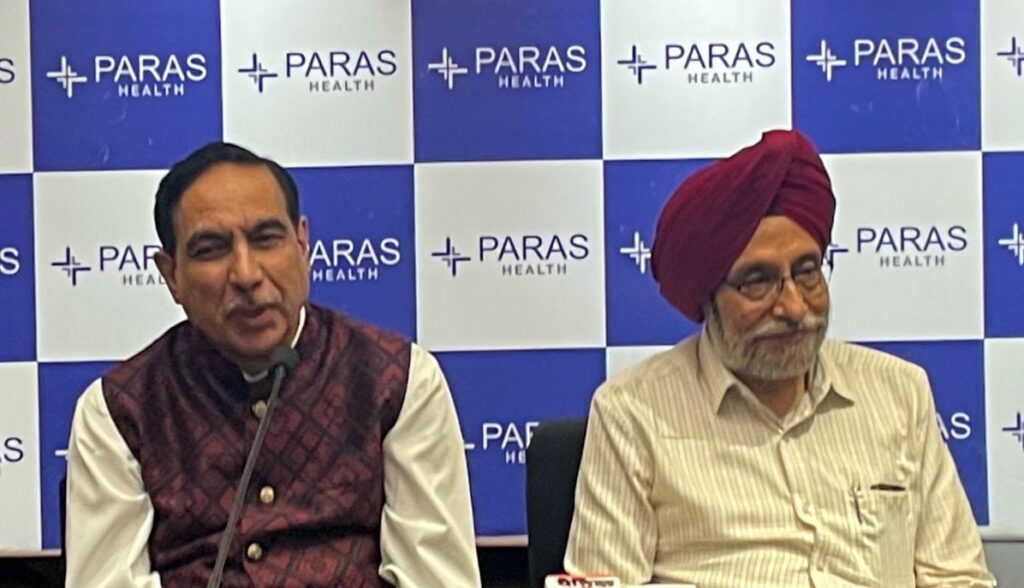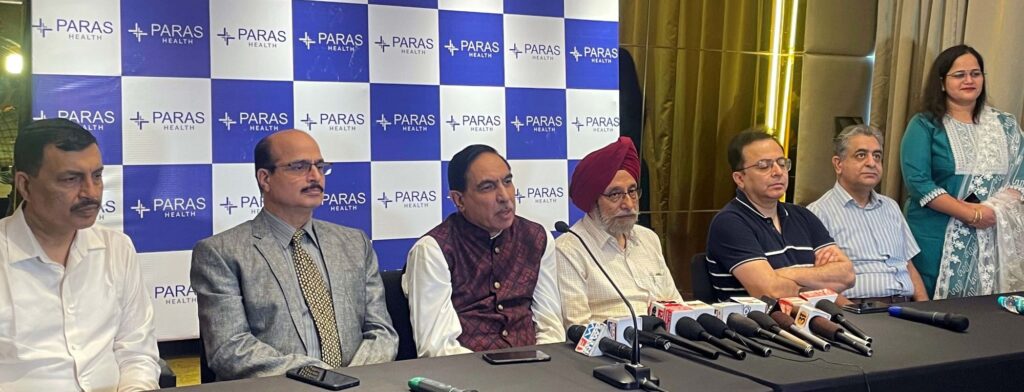
Rare & comprehensive heart valve treatment now at Paras Health Panchkula
Aortic Valve Replacement with Non-Surgical Procedure called TAVR- A Boon For Elderly and high surgical-risk Patients
The Voice of Chandigarh : With a view to creating awareness on ‘Heart Valve Problem & Non-Surgical Treatment of Heart Valves’, a team of Doctors from Paras Health, Panchkula, addressed media persons. During the media interaction, from Paras Health, Panchkula’s Chairman of the Cardiac Sciences, Paras Group of Hospitals Dr H.K. Bali; Associate Director, Cardiology, Dr (Major Gen) Naveen Aggarwal; Associate Director, Cardiology Dr Arvind Kaul; Associate Director, CTVS Dr Veenu Kaul; Cardiac Anaesthetist Dr Akashdeep Singh; President IMA Chandigarh Dr Gurvinder Singh and Secretary IMA Chandigarh Dr Vivek Malhotra were present.

Addressing the media persons, Chairman Cardiac Sciences Dr. H.K. Bali said, “Valve replacement surgery is conducted to replace the damaged or diseased cardiac valve. During a typical heart valve replacement, the damaged or diseased valve is replaced with a biological or synthetic valve, choice of which depends on the condition of the patient. There are four types of cardiac valves – aortic, mitral, tricuspid, and pulmonic. Any of these valves may get diseased or damaged during a person’s lifetime. However, heart valve replacement is most commonly performed on diseased or damaged aortic valve.”
“The main indication for conducting Aortic Valve replacement is Aortic Stenosis, which is a condition in which the aortic valve which is inverted between the left ventricle and the aorta, that supplies blood to the whole body, gets severely thickened and narrowed. “This condition is more often seen in the Elderly population. Although the main reason for Aortic stenosis is age-related degeneration, other reasons can be congenital malformation in valves and Rheumatic heart disease. Treatment for this severely narrowed Aortic valve for long has been Aortic Valve replacement by Open Heart Surgery. This was the only option available till twenty years back. Therefore, elderly and high-risk patients not suitable for surgery had the option of medical management only”, Dr. Bali elaborated

“When the stenosis reaches the stage of critical narrowing, the heart is unable to pump sufficient blood to the whole body, resulting in breathlessness, fatigue, chest pain, swelling in legs and transient loss of consciousness. Severe Aortic stenosis is a progressive life-threatening condition and in the absence of valve replacement, the survival after onset of symptoms is 50% at 2 years and 20% at 5 years. There is also a 1.5-2% per year risk of sudden death. So, intervention for severe aortic stenosis should be performed promptly, once even minor symptoms occur”, Dr Bali added.
Open Heart Surgery for valve replacement is not suitable in many elderly patients especially patients, who are in the age group of 80 years and above and who have other comorbid conditions like low ejection fraction (Low pumping of Heart). “Now, there is an option of the latest non-surgical technique of Aortic Valve replacement – TAVI (Trans catheter Aortic Valve Implantation or TAVR (Trans catheter Aortic Valve Replacement). It is a totally non-surgical treatment, where there is no need to open the chest of the patient surgically, there is No blood loss, negligible chances of infection, the procedure can be performed in 1.5-2 hours and the patient can be discharged in 2-3 days”, he informed. Dr. Bali shared that as of today in India, around 600 TAVI cases are performed annually, whereas in the USA approx. 80000 thousand TAVI cases are done annually.

Dr Bali also informed that there are many patients who have previously undergone surgical aortic valve replacement into bioprosthetic valve. Over the years some of these patients develop degeneration of the surgical valve and need valve replacement again. Surgery in these patients by doing a redo valve replacement causes a high risk. These patients can also be treated with the non-surgical TAVI safely and the procedure is called valve in valve. Dr Bali informed that at Paras Health Panchkula we have done quite a few valve in valve TAVI with very good results.
In his address, Dr. Naveen said, “Till a few years back, TAVR was recommended only in high-risk and inoperable patients. In 2016, it has been approved in intermediate-risk patients as well. Recent trials have shown TAVI to be feasible for the low-surgical-risk group also. TAVI procedure is conducted through one of the arteries in the groin, similar to how Angiography was performed earlier. The Valve is implanted by Endovascular technique. After the procedure, the groin artery is closed with internal suture devices and the patient can be discharged within 2-3 days. With advancements in Medical technology and the introduction of the lesser Invasive technique, TAVI for Aortic valve replacement, there is a ray of hope for old, high-risk, inoperable patients and a suitable Non-Surgical alternative in other patients, who are going for surgical valve replacement.”

Symptoms of Valves Disease
- You may not experience any symptoms of heart valve problems if the condition is mild to moderate. However, in case of severe heart valve disease you may experience symptoms such as:
- Fatigue
- Breathlessness
- Cough
- Chest pain
- Palpitations
- Dizziness or loss of consciousness
- Swelling of limbs and abdomen
The benefits of Noninvasive heart Valve Replacement – TAVI
- First and foremost is the fact that this procedure is totally Non-Surgical and there is no need to take the patient on a cardiopulmonary bypass pump. No bones are cut. This has several advantages in reducing pain, retaining function and no muscle cut.
- Second, unlike traditional heart Valve replacement surgery, returning to normal life including driving or other activities is not disrupted and can be started almost in a week’s time.
- Third, there is no blood loss as such, eliminating the need for blood transfusion and subsequent blood borne infection.
- Fourth, all infections are reduced, whether it be wound infections or post-surgical lung infection. This makes the TAVI a procedure of choice in high risk, elderly patients, who are not fit for Open Heart surgery.
- Fifth, the incision is so cosmetic and measures just 2-3 inches that it is practically impossible to tell that a heart operation has been done.
- Sixth, the Hospital stay is only four days, unlike the conventional heart surgery that requires 8-10 of Hospital stay.
- Lastly, this procedure makes heart surgery possible for patients, who were previously considered too high risk for traditional surgery due to age or medical history.
